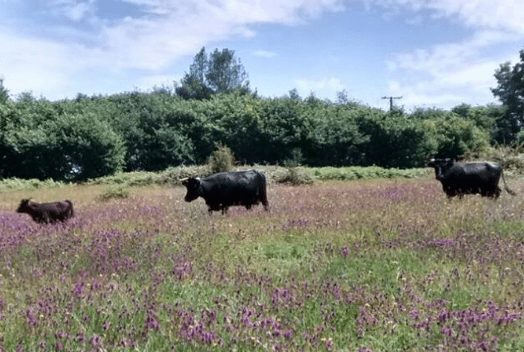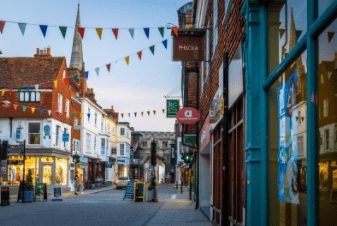Community land trusts – or CLTs – are democratic, non profit organisations that own and develop land for the benefit of the community.
They typically provide affordable homes, community gardens, civic buildings, pubs, shops, shared workspace, energy schemes and conservation landscapes.
Run by ordinary people. They are community organisations run by ordinary people who want to make a difference to their local community, putting control of assets into the hands of local people. They can be set up by the community or a landowner, developer or council.
Protecting community assets forever. They ensure that their homes are permanently and genuinely affordable. CLTs act as long-term stewards of land and the assets on it. They ensure that it is put to the benefit of the local community, not just for now but for every future occupier.
A world wide movement. Started by black leaders in the civil rights movement and others in the peace movement in the USA, CLTs are now a worldwide movement. In both urban and rural areas, CLTs are a key part of the future of land, affordable housing and community facilities.
Jump to a section to find out more
The CLT movement is growing every day
Across the country, in urban and rural areas and across communities
CLT groups in England & Wales
CLT projects in England & Wales
completed afforable CLT homes
CLT homes in the pipeline
Why CLTs?
People set up and join CLTs for all sorts of different reasons.
Lack of affordable housing. It might be that there is a lack of affordable homes for young people or families in the village or neighbourhood. Maybe local people are having to move out of the place they call home because of rising prices and the community wants to do something about it.
Turning around local areas. Or it might be that the area has suffered years of decline and disinvestment, leaving empty properties and blight, and the community want to bring homes back into use and turn their neighbourhood around.
Shaping their local area, long term. Or, maybe a landowner or developer wants to vest the public facilities and green space in their new development into a trust. The CLT can steward them for the long term, and continue to develop the place long after the developer has built their last home.
In all these cases, the community wants to make their area a better place to live and they want more control over how that happens.
“We don’t want to sit back and accept things being done to us. We say stop, say no, and change the situation for the better.”
“With less money in the government coffers, the CLT approach provides a way of communities delivering their own services, housing, pubs, community enterprises. I really think it’s the way of the future.”
Beyond housing
CLTs to date have focussed on creating new affordable housing – but it’s not limited to housing.
Communities across England and Wales have come together, especially during the pandemic, to set up and provide a whole range of community assets and facilities. From village shops and community pubs, to energy generation schemes or food growing initiatives.
Community Enterprises
CLTs have set up and run a range of community businesses and enterprises. Where local shops have been in danger, communities have stepped in to take on ownership of an important community shop or asset.
- Local pubs: In many areas, the pub has historically been the focus of community space. Now CLTs are running community pubs. Community hubs as well as a place for a pint, with childcare, post offices, older people’s meeting space, meeting rooms, even health services.
- Community Centres: CLTs can own and run community centres, community sports facilities and other communal spaces such as community cafes.
- Community workspaces, studios and pop-up shops: CLTs have also taken on commercial spaces important to their local areas, especially as the pandemic threatened to shutter them.


Community Energy Generation
Lots of community groups are considering how they can make their communities more sustainable by generating their own renewable energy. This is a win-win – caring for the environment, reducing costs for residents and also creating the potential to generate income for the CLT.
Food and Farming
When community members talk about the things they would like to see in their community, very often land for growing food or preserving nature emerges as important.
Some CLTs have made land available near to the homes built for allotments, and some groups have larger ambitions for community owned farms.

Read our jargon busting A-Z of CLTS


Legal structure of CLTs
CLTs are not a legal form in themselves (like a company). However, since 2008 CLTs have been defined in law (now in section 2, para 7A of the Leasehold Reform (Ground Rent) Act 2022), which means there are certain things that a CLT must be and do:
A CLT must be set up to benefit a defined local community.
‘Local community’ means the individuals who live or work, or want to live or work in a specified area.
A CLT must be not-for-profit
This means that they can, and should, make a surplus as a community business, but that surplus must be used to benefit the community.
Local people must be able to join the CLT
Those living and working in the community must have the opportunity to join the CLT as members if they support the CLT’s aims.
Those members control the CLT
Members must have a controlling vote in Annual General Meetings and the Board, though other stakeholders can be included in the governance.
CLTs have to take on a legal form that works for them. We can advise on the different legal formats and can help you set up your legal structure.
See our incorporation service for more information.
Not just CLTs
Community land trusts are just one form of community led housing. Other types include cohousing, development trusts and housing co-operatives.
We are part of the Community Led Homes Partnership. We work closely with and support a national network of local and regional Enabler Hubs that provide technical and development advice and support to all forms of community led housing. Visit the website www.communityledhomes.org.uk to learn more.
FAQs – community land trusts (CLTs)
Key questions about community land trusts / CLTs
What is a community land trust?
Community land trusts (CLTs) are a form of community led housing, run by ordinary people to own land and develop homes as well as other assets important to that community, like community enterprises, food growing or workspaces. CLTs act as long-term stewards of land and assets, ensuring that homes remain genuinely affordable – based on what people actually earn in their area – not just for now, but for every future occupier.
Why set up a CLT?
CLTs empower local communities to come together to solve the challenges facing them. It’s a way to take control within their local areas – whether housing or local facilities and assets such as the local shop or pub. It makes communities partners and clients, instead of consultees and consumers.
As CLTs are part of a wider movement and recognised as a vehicle to do this, others may be more willing to support these community efforts. Such as funders, financial institutions or even your local planning authority. And of course, CLTs all support each other as well as being part of this national network.
What do you mean by ‘community’
For CLTs, the community is a geographic description. It is up to the members of the CLT to determine what area the trust will seek to serve. This is usually a local parish, a town or a neighbourhood within a city. The community then means all the people that live and work, or want to live and work, within the defined geographical area.
Are all CLTs set up by local people?
Most CLTs have historically been set up by local people from the outset. However, that is changing as more developers, housing associations, local authorities and more see the benefits that CLTs can bring to areas and major schemes.
Where they are not initiated by local people, the aim should be to develop a local membership and give control to the members as soon as possible. Sometimes this means partnership structures to protect and balance the interests of all parties.
How does a CLT create affordability?
To create affordability a CLT needs to receive initial subsidy in one form or another; be it free land or financial grants from government, charities or benefactors. Once properties have been built, the land on which they are built is protected from fluctuations in land market valuations by a legal ‘asset lock’ that is a fundamental part of all CLTs’ structure.
Are CLTs just about building homes for sale?
No! CLTs usually have wider ambitions than to just provide affordable homes for sale. They set out to address local housing needs, whatever that need may be. It might be a young person seeking rent they can afford, a family seeking to buy a share in their home, or an elderly person seeking to downsize to more appropriate accommodation, freeing up a larger family home in the process.
CLTs are also providing opportunities for self-builders, mutual homes ownership and co-housing schemes. The latter are very prevalent in continental Europe and there is growing interest in their development in the UK as an alternative to traditional mortgage-based options. Land owned by a CLT is the perfect place to try out some of these new ideas.
Where does a CLT get its land?
CLTs acquire land in a variety of ways. Usually land needs to be bought at a low cost in order to enable the development of affordable homes (if the land price is too high then the scheme might not work financially).
Examples of how CLTs acquire land are:
- Land could be bought from a private landowner. This kind of site is sometimes suitable if it is on the edge of a settlement and is a site that can only be developed for affordable homes for local people (an exception site in planning terms).
- Land could be bought at a discount or gifted by a public body like the local authority, or a community minded landowner like a charity if they are in support of the aims of the CLT.
- Land could be bought at a discount or gifted to the CLT by a developer as part of the contribution they must make to the community as part of their planning agreement (known as a section 106 site).
How is community ownership of the land protected for the future?
CLTs hold their assets in perpetuity, though they need to have the flexibility to respond to changing circumstances. The CLT’s legal ‘asset lock’ dictates that assets can only be sold or developed in a manner which benefits the local community. So if a home is sold, the cash realised is protected and can be re-invested into something else that the trust’s members think will benefit the local community.
How are CLTs run?
CLTs are locally driven, controlled and democratically accountable. They have a membership that is open to all who live or work in the defined community, including occupiers or users of the land and properties that the trust owns. The members elect a volunteer board to run the trust on their behalf on a day to day basis. Usually, the board comprises a balanced mix of supportive local residents, tenants and employers; people from the wider area with useful skills to offer; and additional stakeholders that seek to preserve the integrity of the trust (perhaps local authority representatives, or those who endow land or property to the trust).
What if we don’t have enough people with the right skills?
We understand that volunteer time is limited and that CLTs can be complex organisations to run. Experience shows that enough people always come forward to work on a CLT for their community when the community is really behind the proposed project. The most important characteristic of a volunteer is passion for the place they live in – other skills can be bought in!
There are regional and local Enabler Hubs which support CLTs and other community led housing schemes to get started and throughout their life. We also provide guidance, best practice, toolkits and training and learning opportunities at regional and national events.
How do you set up a CLT?
All CLTs start with local people coming together to work on a project to help to make their community a better place.
Find out about starting a CLT here. Or attend one of our training events to find out about the steps involved in setting up and running a CLT.
How does a CLT get funding?
CLTs are all financed in different ways. Finance can come from a variety of sources, from grants to loan finance. The final balance of funding will depend on local circumstances and the objectives of the trust. Your local enabler hub will be able to help you look at different finance options. It is extremely rare for CLT members to fund the development themselves.
Can a CLT partner with a housing association?
Many successful CLTs have partnered with a housing association to help them to deliver the homes that their community needs. Housing Associations are experienced in funding, building and managing affordable homes, so can bring a wealth of experience to a CLT led project and can help community groups to get projects off the ground.
There are a number of ways that a CLT can partner with a Housing Association. Your local community led housing Enabler Hub will be able to let you know which Housing Associations in your area are interested in working with CLTs and can support you in developing relationships. Be sure to see the practical guide to partnerships between housing associations and community led housing organisations (member only). If you are a housing association looking to partner with CLTs or learn more about partnership, consider our associate membership.
The history of community land trusts (CLTs)
Started in the US, CLTs are part of a worldwide movement.
The community land trust movement is a young and rapidly growing movement in England and Wales, where there are now over 500 CLT groups.
However, CLTs are not an altogether new and unfamiliar concept. There is a long history of community ownership and management of land and housing in this country. For example, the original Garden Cities had a community trust that owned and managed the assets on behalf of the community, and some still do.
The CLT model itself is an import from the United States, where CLTs are widely recognised as a common method of delivering permanently affordable housing. There are over 240 CLTs in the United States and the largest CLT, Champlain Housing Trust in Burlington, Vermont, owns over 3,000 homes and over 130,000 square feet of commercial and community facilities.
The CLT model emerged in the USA during the civil rights movement, where a number of influential figures in the movement, including Bob Swann and Slater King (cousin of Martin Luther King Jr) wanted to create long-term opportunities for economic and residential independence for African Americans in the rural south. A CLT, where land is held by the community in trust, could do just that.
To inform the CLT model, they borrowed from older ideas of common ownership and the stewardship of land for wider community benefit and looked East, taking inspiration from the Gramdan movement in India as well as the leased-land agricultural cooperatives in Israel.
The first CLT, New Communities Inc, was created in 1969. However, it wasn’t until the 1990s that the CLT movement really started to flourish in the USA, thanks to a favourable policy and funding environment and a lot of shared learning amongst the CLTs. CLTs are now a commonly known delivery model for providing permanent affordable housing.
For an excellent history of the USA CLT movement, watch Roots of the CLT above.
In the early 2000s in England, the CLT movement in the US served as an inspiration for a number of academics and housing and community development professionals. In 2006 to 2008, a National CLT Demonstration programme, led by Community Finance Solutions, with support from Carnegie UK Trust and Tudor Trust, supported a number of pilot projects.
In 2010 the Community Land Trust Network (then called the National CLT Network) was established to support the growing CLT movement and advocate on behalf of CLTs. There are now over 500 CLTs and the use of CLTs has started to spread to all parts of England and Wales. The Community Land Trust Network launched as an independent charity in June 2014.
There is an emerging CLT movement in several European countries. Visit the website of our friends at the Sustainable Housing for Inclusive and Cohesive Cities (SHICC) project to learn about case studies, European policy and a European financing strategy.




